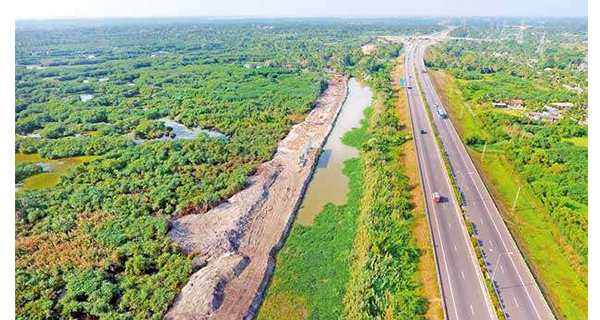There is a crisis situation in the Muthurajawela Wetland Zone regarding the illegal acquisition of lands in the Muthurajawela Ecologically Sensitive Zone by the Urban Development Authority through a gazette notification.
Recently, Gampaha District Samagi Janabalawegaya Parliamentarian Kavinda Jayawardena and a fisherman from the Negombo area K. S. N. Fernando had also filed a preliminary petition in the Supreme Court.
It called for a ruling that violates the fundamental human rights enshrined in the Constitution through the decision taken to illegally take over the lands in the Muthurajawela Ecologically Sensitive Zone to the Urban Development Authority through a Gazette Notification.
Recently, environmentalists as well as civil society organizations have stated that the Muthurajawela land is being filled illegally. But the government has denied the allegations. However, it was revealed that at the Gampaha District Coordinating Committee , due to land reclamation in Muthurajawela, heavy flood situation has arose in Gampaha.
However, it has been revealed that there is an attempt to set up a helicopter yard in the Muthurajawela reserve.
Muthurajawela is an empty paddy field in the Gampaha district of Sri Lanka. Muthurajawela is a biodiversity hotspot in Sri Lanka, bordered by the Negombo Lagoon to the north, the Kelani River to the south, the coast to the west and the Colombo-Negombo main road to the east. Together with the Negombo Lagoon, the Muthurajawela wetland covers tens of thousands of hectares.
The Muthurajawela wetland is an ecosystem with a very high biodiversity. Therefore, the bird species that live here include both native and exotic birds. This is a wetland that is self-sufficient in its own mangrove environment, a variety of birds and amphibians, as well as a variety of insects and aquatic plants.
This wetland is home to many species of animals and plants. It is directly connected to the lagoon and provides livelihood to about 3200 fishing families. About 15% of Sri Lankan fishing vessels use the Muthurajawela lagoon as an anchorage. The area is a breeding ground for fish and prawns and a source of vegetables, fruits, medicines and timber. The Muthurajawela wetland, which acts as a green lung in the densely populated area of Greater Colombo, also contributes directly to natural flood control.
The Muthurajawela Wetland, which supports the fishing industry, which is the main livelihood of the people of the area, also contributes to the tourism industry. The main reason for this is the natural beauty that pervades the area. The two main canals along the Muthurajawela, the Hamilton Canal and the Holland Canal, are an integral part of that natural beauty. The lush green mangroves on either side of the canals are also a sight to behold. It also adds to the uniqueness of the “Bird Garden” area beyond the mangroves. According to internet sources, the park is home to both native and foreign migratory birds.
The total extent of land belonging to the Muthurajawela Sanctuary is 1285 hectares. Out of this area, 543 hectares of agricultural lands are home gardens. The extent of coconut land is 430 hectares. An area of 6 hectares has been set aside for grassland. Negombo Lagoon which belongs to this wetland boundary is also a very important place in the area. The number of families living in the vicinity of the Muthurajawela Lagoon, which is the main livelihood of the people of the area, is approximately 3200.
The Droni estuary is a place where seawater mixes with water from surrounding rivers and provides good water insurance for lagoon life. Furthermore, by purifying the water flowing from the catchment area and sending it to the sea, a large amount of silt can be prevented from flowing into the sea.
The lagoon’s organisms continue to receive essential nutrients for economically advanced species such as shrimp, crabs and fish. These swamps also intervene to reduce flooding. Muthurajawela is a dumping ground for more than 200,000 people, according to internet sources.
It has been reported that approval has been granted to build a large helicopter yard in the Muthurajawela Ecological Zone. This was revealed at the Parliamentary Committee on Public Accounts. The Parliamentary Committee on Public Accounts has instructed the Director General of Wildlife, Chandana Sooriyabandara, to submit an immediate report in this regard.
The COPE Committee has also recommended an investigation into the unauthorized entry into the Muthurajawela Wet Zone and the damage caused to the ecosystem. The committee has also ordered the suspension of all project licenses that are detrimental to the ecosystem. The COPE Committee states that a private company has taken action to purchase 65102 perches from the Muthurajawela Wetland at Rs.500 per perch and no investigation has been conducted against the Agrarian Service officers who assisted in this.
The COPE report states that 3068 hectares of the 6232 hectare Muthurajawela reserve have been identified as ecologically important wetlands. The COPE Committee has also instructed to set up a committee on the Muthurajawela ecosystem headed by the Secretary and with the participation of relevant institutions to take steps to protect that ecosystem.
